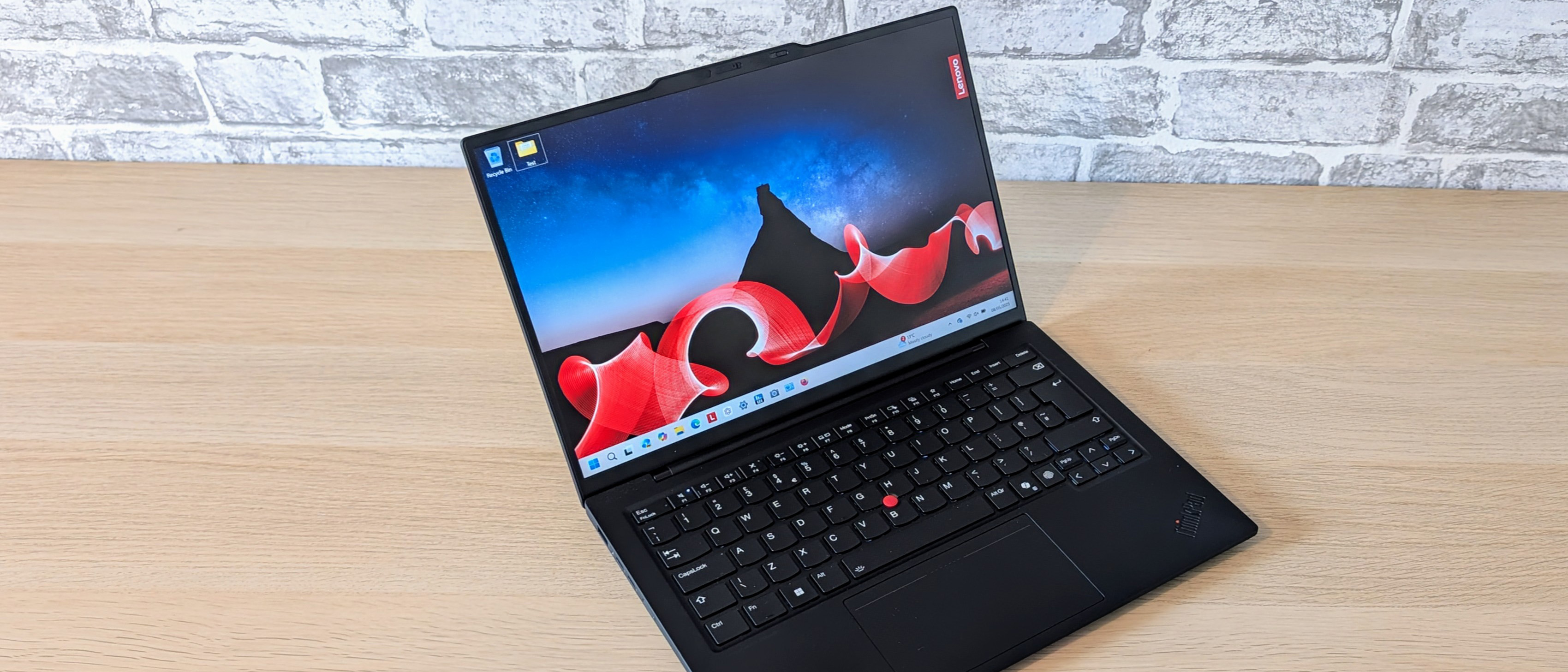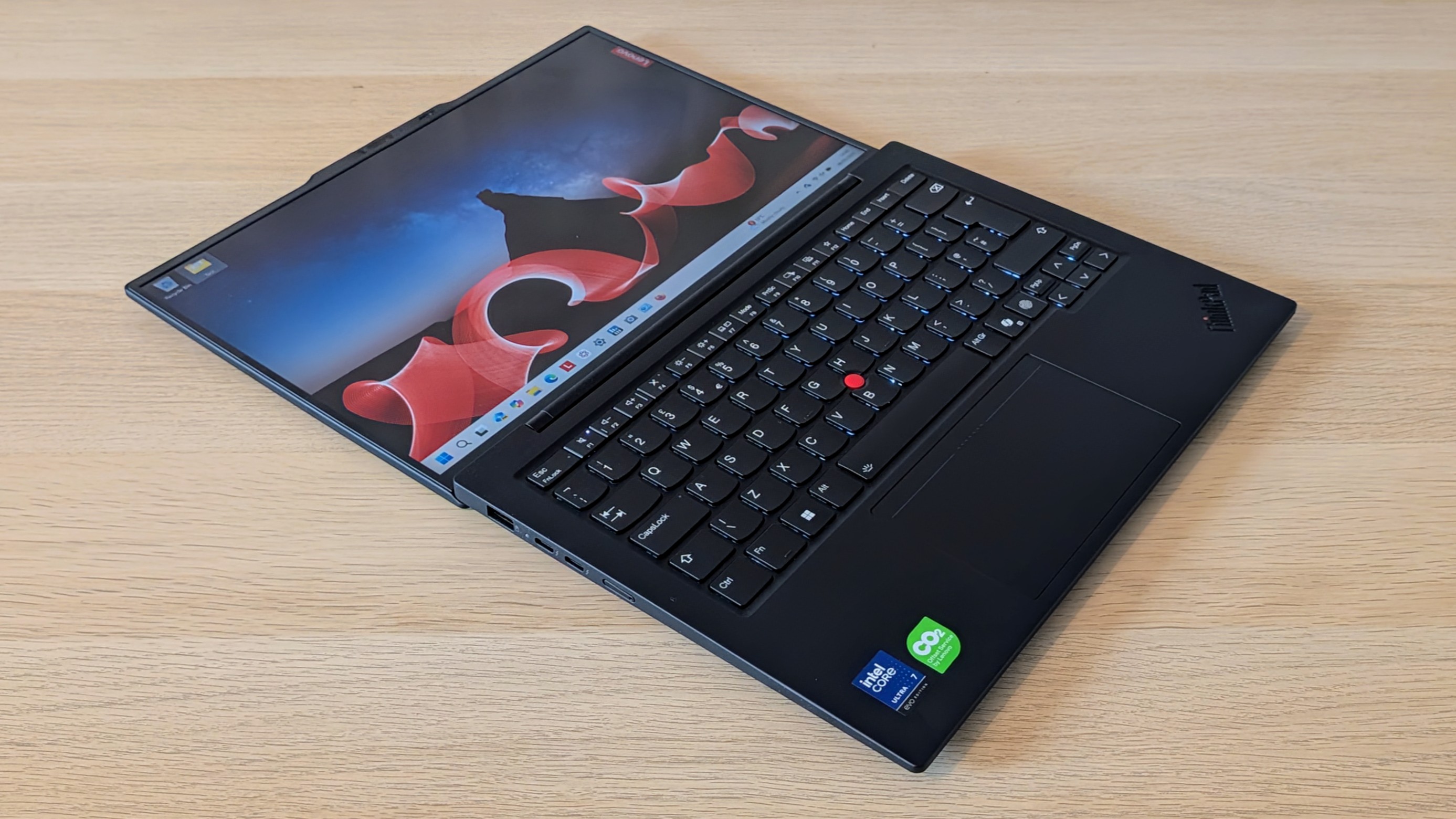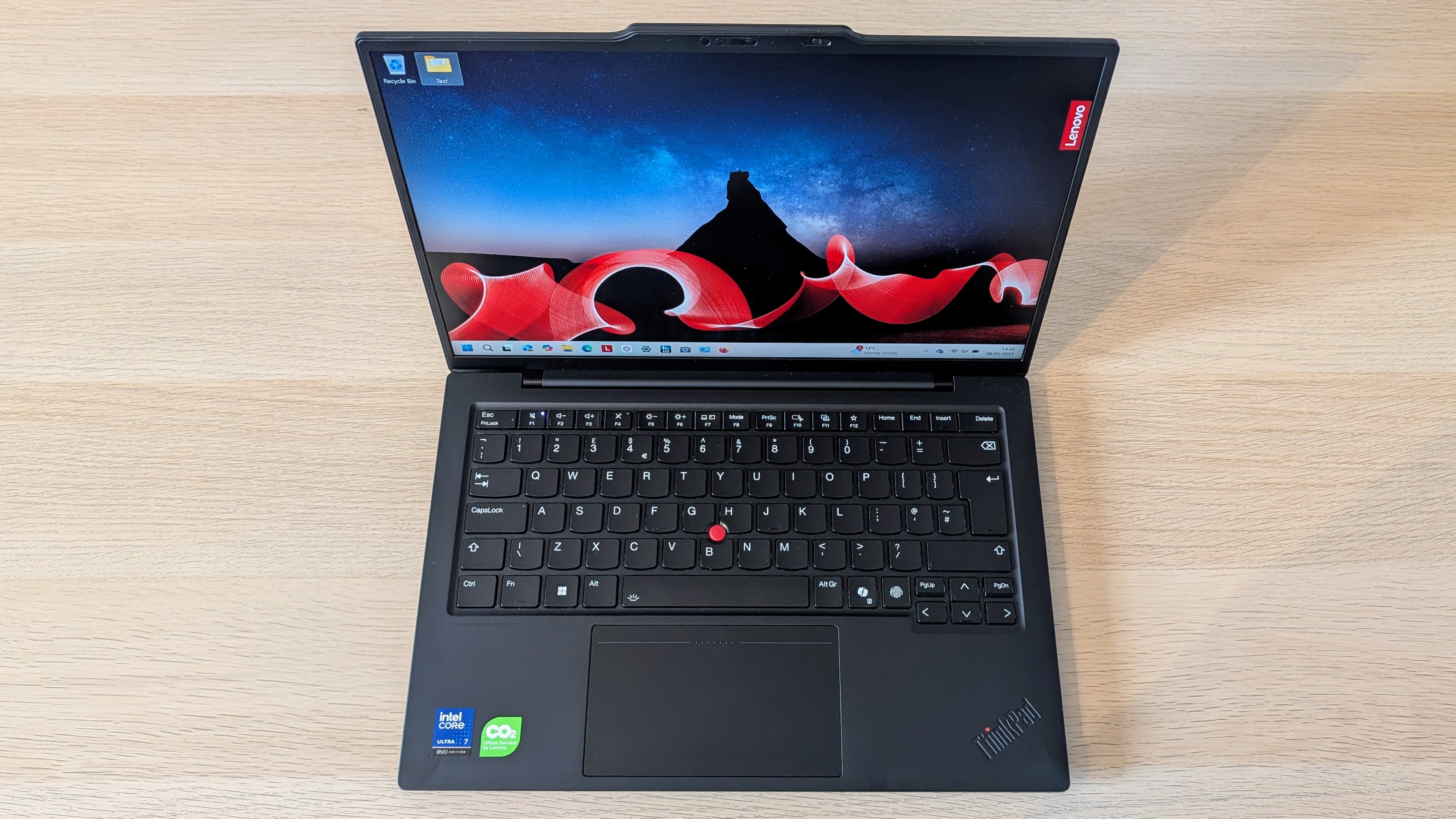The Lenovo ThinkPad X1 Carbon Gen 13 Aura Edition is the best compact business laptop in the world
The new S2 Core Ultra processors fix the only thing wrong with the X1 – its battery life

-
+
Superb build quality
-
+
Wide array of options
-
+
Fast SSD
-
+
Class-leading keyboard
-
+
Stellar battery life
-
-
No memory card slot
-
-
No space for a second SSD
-
-
The M4 MacBook Air is more powerful

When we reviewed the Gen 10 model of Lenovo's ThinkPads X1 Carbon back in 2022, we called it "quite simply the best compact business laptop". Skip ahead 3 years, and the new X1 enters a wholly different laptop market populated by Qualcomm ARM-powered Windows laptops with epic battery lives and new, more potent MacBooks. To keep its crown, the Gen 13 machine is going to need to be very good.
Before we get into the long grass, it's worth mentioning what makes this an "Aura" machine. Aura is Lenovo-speak for a range of smart modes that leverage the AI capability of the NPU on the chipset.
One example is Shield, which aims to improve user security by using a proximity sensor to blur the screen if you move away from your laptop or someone looks over your shoulder. Another called Attention reduces distractions by limiting notifications for a set duration, while Wellness keeps an eye on your well-being by monitoring your posture and time spent looking at the screen.
Many of the features in Aura are standard parts of Windows 11, but Lenovo has grouped them in the Commercial Vantage app and an associated widget, which can be accessed by a quick tap of the F8 key.
Lenovo X1 Carbon Gen 13 Aura Edition: Design
Lenovo hasn't messed with the successful X1 recipe, so it's still a very solid and angular black piece of kit made from a combination of carbon fiber and metal. For 2025, however, aluminum has been replaced by magnesium to reduce weight. Like all ThinkPads, the new X1 has passed a raft of MIL-STD 810H tests to guarantee its resilience to shock, vibration, particle ingress, and temperature extremes.
For such a solid laptop, the new ThinkPad X1 is impressively light and petite, weighing just 982g and measuring 313 x 215 x 15mm. That makes it lighter than the 13.6-inch MacBook Air but only a couple of millimeters wider and thicker despite the larger screen.
Two features we particularly like about the X1 are that the screen folds back through 180 degrees and that you can open the lid using just one finger, no mean achievement for a laptop weighing as little as the X1.
Sign up today and you will receive a free copy of our Future Focus 2025 report - the leading guidance on AI, cybersecurity and other IT challenges as per 700+ senior executives
Lenovo hasn't messed with the port selection or layout from the Gen 12 ThinkPad X1 so on the left you still get two Thunderbolt 4 ports and a 5Gbps USB-A port while on the right there is another USB-A port, an HDMI 2.1 video output, a 3.5mm audio jack, a Kensington lock and the on/off button.
In a more utopian world, we would have liked a memory card slot, for the USB-As to be bumped up to 10Gbps, and for the Type-C ports to be placed one on either side, so you can choose which side to attach the small 65W rat-and-tail USB-C charger to.
Getting inside the X1 is easy enough, but apart from blowing dust out of the fans and swapping the battery and M.2 2280 SSD, there's nothing else you can do. There is no space for a second SSD, the RAM is fixed as it is in all Core Ultra S2 chipsets, and the wireless card is soldered in place.
Wireless communications are handled by a Wi-Fi 7-capable Intel BE201 card, which also supports Bluetooth 5.4. Our review sample also had the optional Quectel RM520N-GL 5G modem, which worked a treat when out and about.

Lenovo X1 Carbon Gen 13 Aura Edition: Keyboard, touchpad and webcam
There may not be any such thing as a perfect keyboard, but the X1 comes very close. The layout is a model of clarity, the keycaps are perfectly shaped with a slight scallop in the top, and the 1.5mm travel is superbly calibrated with a smooth but precise end-stop. The keyboard deck is more solid than most, too.
Other positives include a set of square, near-full-size cursor keys, a fingerprint scanner that's out of harm's way next to the Copilot button, a two-stage backlight, and a function lock, something it should be illegal to sell a laptop without.
And of course, this being a ThinkPad, a bold red TrackPoint is nestling between the G, H, and B keys. If you've ever had to use a laptop in a truly confined space, you'll know what a benefit this is, and it's the main reason you should consider the ThinkPad X1 over the ThinkPad X9.
To make the TrackPoint even more useful, a quick double tap launches a menu that lets you adjust the sound and mic settings, launch Microsoft's Speech Services, and adjust the touchpad haptics.
The X1 can be optioned with either a mechanical or a haptic touchpad. The former option, called TrackPad, comes with the traditional dedicated mouse buttons at the top to use with the TrackPoint pointing stick, while the haptic TouchPad from Sensel uses virtual zones to achieve the same effect.
While the mechanical touchpad will doubtless appeal to hardcore ThinkPad users, we were mightily impressed by the haptic alternative, which our review machine came fitted with.
It features a 120 x 70mm semi-matte glass surface that's very pleasant to touch. Thanks to the haptic engine, you can click anywhere and also adjust the strength of the haptic response.
The upper part of the haptic touchpad works as the right, left, and middle mouse buttons in conjunction with the TrackPoint, with the middle or scroll button demarcated by a row of raised dots and the left and right click zones by light grey lines.
All in all, it is one of the best touchpads we've come across on a laptop, with some in the office preferring it to the mechanical option, heretical though that might sound.
Our ThinkPad X1 featured the high-quality optional 8MP, 1440p webcam, which supports Windows Hello facial recognition, Windows Studio AI enhancements and has a physical shutter slide.
The camera's video feed looked bright, sharp, and colorful even in seriously suboptimal lighting conditions, and we didn't get the distracting fuzzy distortion around our heads when we blurred the background.
We've recently encountered a couple of excellent webcams in the latest MacBook Air and the new Dell 13 Pro, but the X1's camera is, albeit by a short head, the best of the bunch.
Lenovo X1 Carbon Gen 13 Aura Edition: Display

The X1 can be bought with four different displays. Three are 1,920 x 1,200 60Hz IPS affairs which can be optioned with or without touch and without touch with a privacy filter. There is also a 2,800 x 1,800 120Hz OLED screen with touch. Our review machine had an entry-level IPS display.
As far as bog-standard IPS screens go, it performed well. Peak brightness measured at an impressive 502cd/m2, and though not a wide-gamut display, it does cover 99.2% of the sRGB gamut volume and recorded a Delta E variance of just 1.3 against the sRGB profile, making it very color accurate.
Thanks to that high peak brightness, the screen has an impressive contrast ratio of 1480:1, which makes images look bold and punchy. Given the price Lenovo is asking for even the cheapest X1, a 120Hz refresh rate should be standard, but that's a minor quibble.
Lenovo X1 Carbon Gen 13 Aura Edition: Specs and performance
All told, the X1 can be had with 12 different Intel Core Ultra S2 processors, though of course some of those are the same but with different amounts of memory, thanks to the Core Ultra S2's integrated RAM. The Aura Edition models come with either the Core Ultra 7 258V or 268V processor with 32GB of RAM and the Arc 140V integrated GPU. Our test sample used the 258V.
Intel designed the Core Ultra S2 chips with efficiency rather than out-and-out performance in mind, but despite that, the X1 turned in some very healthy benchmark results: 6,909 in the PCMark10 test, 245 in ITPro's bespoke 4K multi-media test and 2,725 and 10,937 in the GeekBench 6 single-core and multi-core tests.
The 4K test result was only 2 points below what we saw from the new M4 MacBook Air, though the Apple machine did enjoy a near 40% advantage in the GeekBench 6 multi-core test. Our 4K benchmark is a good test of everyday use and includes heavy multitasking, so the advantage the MacBook enjoys in processor speed isn't something you'll notice in everyday use.
There's no need to repeat the assertion that Intel's latest 140V and 140T Arc integrated GPUs are a huge step forward from the Xe, suffice it to say the X1 can run the SPECviewperf 3dsmax 3D modeling benchmark at 27fps, close to double what an Xe iGPU can manage.
In our usual stress test, the X1 did well. After an hour of running flat out, the CPU utilization dropped to 80% while the GPU stayed nailed to 100%. Even at full chat, fan noise is impressively subdued, though it's noisier than the passively cooled MacBook Air.
While Intel's Core Ultra 258V can't match Apple's latest M4 for CPU performance, it can beat it like a drum in a heavy metal band in the arguably more important arena of battery life.
Battery life has always been the Achilles heel of the X1 but Intel's new S2 Core Ultra chips have fixed that problem and then some: The new X1 ran for a mightily impressive 20 hours and 45 minutes in our standard video rundown test.
That's an outstanding result, a good six hours better than you'll see from an M4 MacBook Air and close to the best we've seen from the new Snapdragon-powered Windows-on-Arm machines.
It's work keeping in mind that this time last year, the MacBook Air was the undisputed battery life king when it comes to ultra-compacts. How times change.
The 1TB SKHynix SSD in our review machine went like the proverbial off a shovel, recording average sequential read and write speeds of 7,999MB/s and 5,164MB/s respectively, which is truly outstanding.
Lenovo X1 Carbon Gen 13 Aura Edition: Is it worth it?
Battery life aside, there has never been much wrong with the ThinkPad X1, and now that that feature has gone from its main weakness to its principal strength, we are even more confident that the Gen 13 ThinkPad X1 is the best compact business laptop in the world.
Granted, the doyen of compact laptops, the MacBook Air, can match it and even better it in some areas, but the X1 is lighter, has a bigger display, can be purchased with either Windows or Linux or without an OS altogether, has a superior keyboard and a much better selection of ports. This may not be Crufts, but the ThinkPad X1 Gen 13 Aura Edition is without doubt the Best in Show for compact productivity laptops.
Lenovo X1 Carbon Gen 13 Aura Edition specifications
Processor | Intel Core Ultra 7 258V | Row 0 - Cell 2 |
RAM | 32GB LPDDR5X | Row 1 - Cell 2 |
Graphics | Intel Arc 140V | Row 2 - Cell 2 |
Storage | 1TB M.2 2280 SSD | Row 3 - Cell 2 |
Screen | 14in, IPS, 60Hz, 1,920 x 1,200 | Row 4 - Cell 2 |
Ports | Thunderbolt 4 x 2, HDMI 2.1, USB-C x 2, USB-A 3.2 Gen 1 x 2 | Row 5 - Cell 2 |
Connectivity | Wi-Fi 7, Bluetooth v5.4 | Row 6 - Cell 2 |
Operating System | Windows 11 Pro | Row 7 - Cell 2 |
Dimensions (WDH) | 313 x 215 x 15mm | Row 8 - Cell 2 |
Weight | 982g | Row 9 - Cell 2 |
Battery capacity | 61Wh | Row 10 - Cell 2 |
Over the years, Alun has written freelance for several online publications on subjects ranging from mobile phones to digital audio equipment and PCs and from electric cars to industrial heritage. Before becoming a technology writer, he worked at Sony Music for 15 years. Quite what either occupation has to do with the degree in Early Medieval History he read at the University of Leeds is a bit of a grey area. A native of Scotland but an adopted Mancunian, Alun divides his time between writing, listening to live music, dreaming of the glens and dealing with an unhinged Norwegian Elkhound. For ITPro, Alun reviews laptops and PCs from brands such as Acer, Asus, Lenovo, Dell and HP.
-
 ‘1 engineer, 1 month, 1 million lines of code’: Microsoft wants to replace C and C++ code with Rust by 2030 – but a senior engineer insists the company has no plans on using AI to rewrite Windows source code
‘1 engineer, 1 month, 1 million lines of code’: Microsoft wants to replace C and C++ code with Rust by 2030 – but a senior engineer insists the company has no plans on using AI to rewrite Windows source codeNews Windows won’t be rewritten in Rust using AI, according to a senior Microsoft engineer, but the company still has bold plans for embracing the popular programming language
By Ross Kelly Published
-
 Google drops $4.75bn on data center and energy firm Intersect
Google drops $4.75bn on data center and energy firm IntersectNews The investment marks the latest move from Google to boost its infrastructure sustainability credentials
By Nicole Kobie Published
-
 OpenAI says prompt injection attacks are a serious threat for AI browsers – and it’s a problem that’s ‘unlikely to ever be fully solved'
OpenAI says prompt injection attacks are a serious threat for AI browsers – and it’s a problem that’s ‘unlikely to ever be fully solved'News OpenAI details efforts to protect ChatGPT Atlas against prompt injection attacks
By Nicole Kobie Published
